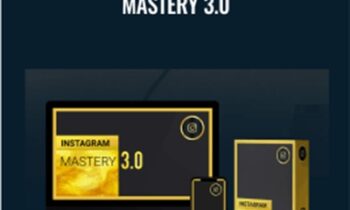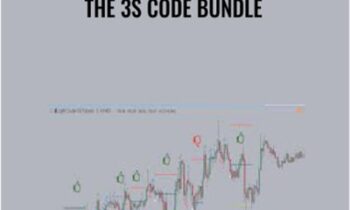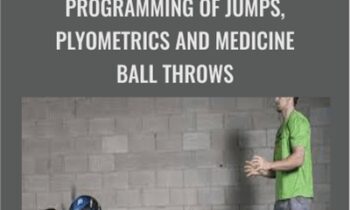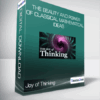Description
Accelerate your learning with the Joy of Thinking: The Beauty and Power of Classical Mathematical Ideas course, priced at just Original price was: $254.00.$48.00Current price is: $48.00. on ESYSGB.com! Explore our extensive catalog of over 60,000 downloadable digital courses across Everything Else. Experience flexible, self-paced learning from experts and save over 80%. Empower your future today!
This is probably not like the mathematics you had at school. Some people might not even want to call it math, but you experience a way File size: 8.20 GB
Purchase Joy of Thinking: The Beauty and Power of Classical Mathematical Ideas courses at here with PRICE $254 $48
Joy of Thinking: The Beauty and Power of Classical Mathematical Ideas
Discover mathematics as an artistic and creative realm that contains some of the greatest ideas of human history. This course explores infinity, the fourth dimension, probability, chaos, fractals, and other fantastic themes.
Hide Full Description
Is it worth Bill Gates’s time to pick up a $100 bill if he sees it on the sidewalk? Amidst the frenzied screaming from the audience on television’s Let’s Make a Deal, is there sound advice to give the contestant trying to decide whether to swi
The world of mathematics contains some of the greatest ideas of humankind—ideas comparable to the works of Shakespeare, Plato, and Michelangelo. These mathematical ideas can add texture, beauty, and wonder to your life. Most importantly, you don’t have to be a mathematician to have access to this world.
A Mathematical Journey
Get Joy of Thinking: The Beauty and Power of Classical Mathematical Ideas download
The Joy of Thinking is a course about fun, aesthetics, and mystery—about great mathematical ideas that arise from puzzles, observations of everyday life, and habits of curiosity and effective thinking. It is as much about learning to think abstractly as it is about what we traditionally think of as mathematics.
You explore the fourth dimension, coincidences, fractals, the allure of number, and geometry, and bring these weighty notions back down to earth to see how they apply to your own life.
Rather than focusing on adding figures or creating equations (in fact, there are fewer numbers than you might expect), this course enables you to uncover and grasp insightful strategies for approaching, enjoying, and understanding the world around you.
“Wonderful … the Best”
Taught by Professors Edward B. Burger of Williams College and Michael Starbird of the University of Texas at Austin, this course is based on their innovative textbook, The Heart of Mathematics: An invitation to effective thinking, which a reviewer for The American Mathematical Monthly called “wonderful … possibly the best ‘mathematics for the non-mathematician’ book that I have seen.”
Paradoxical Phenomena
Consider these examples:
The game show Let’s Make a Deal® entertained viewers with Monty Hall urging contestants to pick a door. The choice involves a question of chance that has been the source of many heated arguments. You explore the mathematics that prepares you for future game-show stardom and explains a paradoxical example of probability.
Coincidences are striking because any particular one is extremely improbable. However, what is even more improbable is that no coincidence will occur. You see that finding two people having the same birthday in a room of 45 is extremely likely, by chance alone, even though the probability that any particular two people will have the same birthday is extremely low.
One of the most famous illustrations of randomness is the scenario of monkeys randomly typing Hamlet. Another, called “Buffon’s needle,” shows how random behavior can be used to estimate numbers such as pi. Physicists discovered that a similar needle-dropping model accurately predicts certain atomic phenomena.
The Fourth Dimension
Mathematical thinking leads not only to insights about our everyday lives and everyday world but also points us to worlds far beyond our own. Take the fourth dimension. The very phrase conjures up notions of science fiction or the supernatural.
Because the fourth dimension lies beyond our daily experience, visualizing, exploring, and understanding it requires us to develop an intuition about a world that we cannot see. Nevertheless, that understanding is within our reach.
You learn how to construct a four-dimensional cube and why a four-dimensional surgeon could remove your appendix without making an incision in your skin.
Fractals
Or take a world that we can see: the two-dimensional realm. It can be just as rich with surprises. You learn how the simple exercise of repeatedly folding a sheet of paper introduces the concept of fractals—a geometric pattern that is infinitely complex—repeated at ever smaller scales to produce irregular shapes and surfaces that cannot be represented by classical geometry.
You discover that the paper-folding sequence offers an example of the classical computational theory of “automata,” developed by Alan Turing—the father of modern computing. Fractal construction processes may also relate to the behavior of the stock market and even to your heart rate.
As Professors Burger and Starbird lead you through these and other examples, you pick up some valuable life lessons:
Just do it. If you’re faced with a problem and you don’t know how to solve it, begin by taking some action.
Make mistakes and fail but never give up. Mathematicians are supremely gifted at making mistakes. The key is to use the insight from your mistakes to identify the features of a correct solution to your problem.
Keep an open mind. If we are never willing to consider new ideas, then we can never hope to increase our understanding of the world around us.
Explore the consequences of new ideas. This strategy pushes us to see where an idea leads and in this way to discover new ideas and insights.
Seek the essential. One of the biggest obstacles in solving real-world problems is the noise and clutter of irrelevant issues that surround them.
Understand the issue. Identifying and clarifying the problem to be solved in a situation is often a significant step in reaching a solution.
Understand simple things deeply. We can never understand unknown situations without an intense focus on those aspects of the unknown that are familiar. The familiar, in other words, serves as the best guide to the unfamiliar.
Break a difficult problem into easier ones. This strategy is fundamental to mathematics and, indeed, applicable in everyday life.
Examine issues from several points of view. We can, for example, gain new insights by looking at the construction of an object, rather than the object itself.
Look for patterns. Similarities among situations and objects that are different on the surface should be viewed as flashing lights urging us to look for explanations. Patterns help us to structure our understanding of the world, and similarities are what we use to bring order and meaning to chaos.
The Un-Math Math
This is probably not like the mathematics you had at school. Some people might not even want to call it math, but you experience a way of thinking that opens doors, opens minds, and leaves you smiling while pondering some of the greatest concepts ever conceived.
One of the great features about mathematics is that it has an endless frontier. The farther you travel, the more you see over the emerging horizon. The more you discover, the more you understand what you’ve already seen, and the more you see ahead. Deep ideas truly are within the reach of us all. How many more ideas are there for you to explore and enjoy? Well, how long is your life?
tch his choice to Door Number 2? How can we see the fourth dimension in a Salvador Dali painting?
These certainly aren’t the kinds of questions you would normally ask in typical lectures about mathematics. But then again, this isn’t an ordinary math course.
Get Joy of Thinking: The Beauty and Power of Classical Mathematical Ideas download
Purchase Joy of Thinking: The Beauty and Power of Classical Mathematical Ideas courses at here with PRICE $254 $48
Build a robust future with the Joy of Thinking: The Beauty and Power of Classical Mathematical Ideas course at ESYSGB.com! Gain lifetime access to high-impact digital content, meticulously designed to boost your career and personal growth.
- Lifetime Access: Permanent and unlimited access to your purchased courses.
- Exceptional Savings: Enjoy discounts of up to 80% off original prices.
- Secure Payments: Your transactions are fully protected and safe.
- Practical Knowledge: Acquire actionable skills for immediate application.
- Instant Availability: Start learning right after completing your purchase.
- Cross-Device Access: Study seamlessly on any desktop, tablet, or mobile device.
Unlock your potential with ESYSGB.com!





























![Joy of Thinking: The Beauty and Power of Classical Mathematical Ideas - eSys[GroupBuy] Joy of Thinking: The Beauty and Power of Classical Mathematical Ideas](https://esysgb.com/wp-content/uploads/2023/04/36701_new.png)

![Joy of Thinking: The Beauty and Power of Classical Mathematical Ideas - eSys[GroupBuy] Joy of Thinking: The Beauty and Power of Classical Mathematical Ideas](http://coursehi.biz/wp-content/uploads/2020/05/Joy-of-Thinking-The-Beauty-and-Power-of-Classical-Mathematical-Ideas1-300x169.jpg)
![Brian Tracy - The 6-Figure Speaker Virtual Training Course - eSys[GroupBuy] Brian Tracy - The 6-Figure Speaker Virtual Training Course](https://esysgb.com/wp-content/uploads/2023/04/2124_new.png)
![Kenrick Cleveland’s - Ultimate Persuasion Factor Package - eSys[GroupBuy] Kenrick Cleveland’s - Ultimate Persuasion Factor Package](https://esysgb.com/wp-content/uploads/2023/04/2615_new.png)
![Sage Lavine - Feminine Enrollment Mastery Training - eSys[GroupBuy] Sage Lavine - Feminine Enrollment Mastery Training](https://esysgb.com/wp-content/uploads/2023/04/Sage-Lavine-Feminine-Enrollment-Mastery-Training.jpg)
![Amy Porterfield - Webinars That Convert - eSys[GroupBuy] Amy Porterfield - Webinars That Convert](https://esysgb.com/wp-content/uploads/2023/04/1780_new.png)
![Craig Garber - Client-Getting Sales-Boosting Ad Writing Workshop - eSys[GroupBuy] Craig Garber - Client-Getting Sales-Boosting Ad Writing Workshop](https://esysgb.com/wp-content/uploads/2023/04/5450_new.png)
![Lisa McElmurry - Lucrative Launch Blueprint - eSys[GroupBuy] Lisa McElmurry - Lucrative Launch Blueprint](https://esysgb.com/wp-content/uploads/2023/04/2743_new.png)
